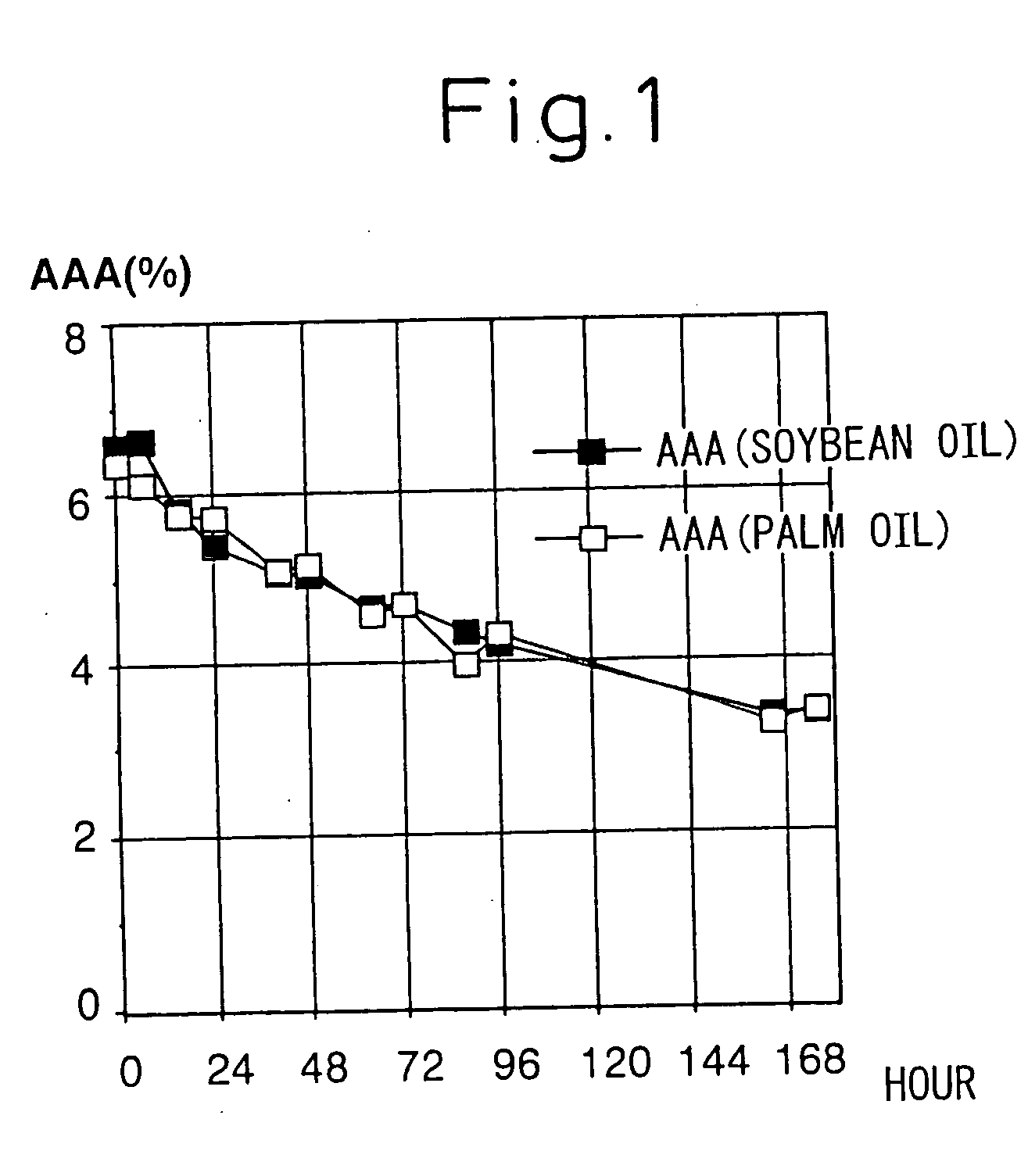Process for production of transesterified oils/fats or triglycerides
- Summary
- Abstract
- Description
- Claims
- Application Information
AI Technical Summary
Benefits of technology
Problems solved by technology
Method used
Image
Examples
example 1
Preparation of Immobilized Enzyme (Conferred Stability and Deoxygenation by Immobilization of 1,3-Specific Lipase)
[0056] After suspending 100 g of an ion-exchange resin (Dowex MARATHON WBA: Dow Chemical) in 80 ml of Rhizopus delemar lipase solution (12.5% Talipase powder, product of Tanabe Seiyaku), the suspension was dried under reduced pressure to obtain the immobilized enzyme. Next, a triglyceride containing 40% arachidonic acid (SUNTGA40S, trade name of Suntory Co., Ltd.) (25 g), palm oil (15 g), the aforementioned immobilized lipase (4 g) and water (800 μl) were weighed out into a sealable bottle. The half-open bottle was placed in a dessicator, and a vacuum pump was connected to the dessicator for pressure reduction of the contents. (Bubbles were produced in the oil from the immobilized enzyme resin placed in the bottle inside the desiccator together with the oil, thus releasing the air containing the immobilized enzyme.) Nitrogen gas was then leaked into the desiccator to re...
example 2
Method of Measuring Fatty Acid Contents of Oils / Fats
[0057] The fat or oil was sampled in an approximately 10-20 mg screw cap test tube, 2 mL of methanolic HCl and 1 mL of dichloromethane were added, the top of the test tube was sealed, and reaction was conducted at 50° C. for 3 hours. After completion of the reaction, the mixture was cooled to room temperature and then hexane was added for extraction of the fatty acid methyl ester and the collected hexane layer was concentrated under reduced pressure. The obtained fatty acid methyl ester was dissolved in hexane to a total fatty acid methyl ester concentration of about 1% and provided for gas chromatography (GC) analysis. The GC analysis conditions and component identification were according to “Fatty Acid Composition by GLC (Method Ce 1 b-89)” of Official Methods and Recommended Practices of the AOCS, 5th Edition (American Oil Chemists' Society, 1998), a Supelcowax-10 column was used. The ratio of the arachidonic acid methyl ester ...
example 3
Method of Triglyceride Analysis
[0058] HPLC analysis was conducted under the following conditions to measure the content of each triglyceride in the oils or fats modified by the enzyme reaction.
[0059] Column: Reverse-phase column (Cosmosil 4.6×250 mm 5C18-MS)
[0060] Solvent: Acetone:acetonitrile (1:1) 1 ml / min
[0061] Analysis time: 55 min
[0062] Column oven temperature: 40° C.
[0063] Detector: Refractive index detector (cell temperature: 40° C.)
[0064] Sample: 5 μl of 10% solution of oil / fat or triglyceride in chloroform
[0065] Each triglyceride was analyzed under the above-mentioned measuring conditions. The molecular species of each triglyceride was determined according to the method disclosed in Japanese Unexamined Patent Publication No. 2000-513575. Specifically, the peaks of each triglyceride were separated, and hydrolysis was then followed by methyl ester conversion. The molecular species were determined by GC.
[0066] By analyzing the triglycerides of the oils / fats obtained w...
PUM
 Login to View More
Login to View More Abstract
Description
Claims
Application Information
 Login to View More
Login to View More - R&D
- Intellectual Property
- Life Sciences
- Materials
- Tech Scout
- Unparalleled Data Quality
- Higher Quality Content
- 60% Fewer Hallucinations
Browse by: Latest US Patents, China's latest patents, Technical Efficacy Thesaurus, Application Domain, Technology Topic, Popular Technical Reports.
© 2025 PatSnap. All rights reserved.Legal|Privacy policy|Modern Slavery Act Transparency Statement|Sitemap|About US| Contact US: help@patsnap.com

